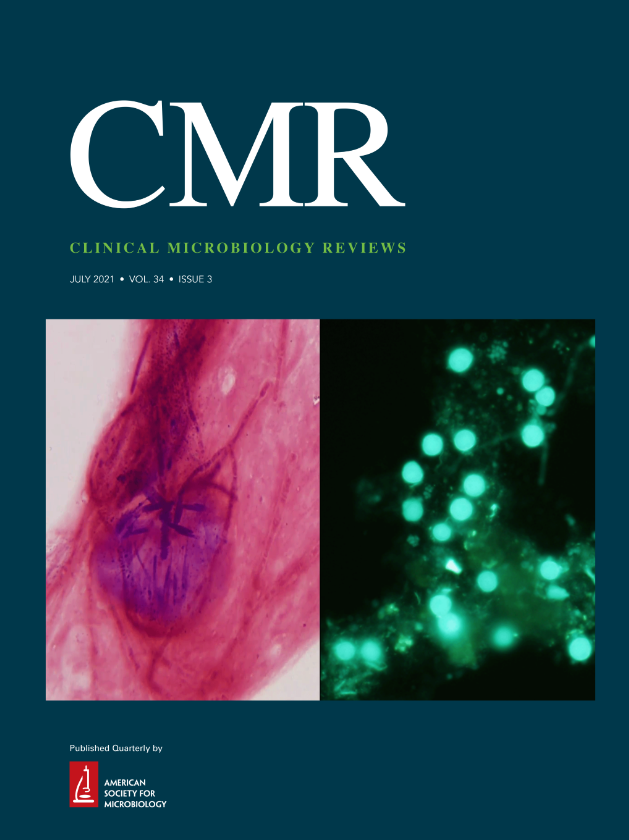挑剔的或很少分离的革兰氏阴性杆状体,特别集中在Kingella kingae上。
IF 19.3
1区 医学
Q1 MICROBIOLOGY
引用次数: 0
摘要
本文所涉及的细菌种类在分类上是多样的。Kingella kingae是一种众所周知的6-36月龄儿童菌血症、骨髓炎和脓毒性关节炎的感染因子,是本综述的重点。自上一篇综述以来,分子诊断工具的最新进展使人们能够从新的方面研究金氏弧菌的发病机制和传播。无创菌株的无症状口咽部定植可以与侵入性克隆区分开来,因此口咽部检测阳性可以假设与K. kingae引起的临床实体相容。此外,新的和不常见的感染可能归因于K. kingae。其他金氏菌属和放线菌属、聚集菌属、嗜碳细胞菌属、心杆菌属、嗜铬菌属、厌氧单胞菌属、艾肯菌属、巴氏菌属、锡蒙菌属、链球菌属和苏氏菌属的临床和微生物学方面分别进行了讨论。用表型方法鉴定大多数属是困难的。直接显微镜和表型关键反应,以及商业上可用的系统,允许识别经常遇到的人类物种。如果要准确鉴定罕见的分离株,分子方法,如16S核糖体RNA基因PCR/测序是必要的。基质辅助激光解吸电离飞行时间质谱法也有帮助。除了只有一种感染原的感染外,上述所有属经常在混合感染中发现。伴随的细菌和临床表现可能指导抗生素的选择。一般来说,可以这样说,根据临床情况对严格的革兰氏阴性杆状体感染进行经验性治疗有时会由于抗生素耐药性而失败。应根据CLSI或EUCAST指南对所有分离株进行药敏试验,以便在必要时调整治疗。本文章由计算机程序翻译,如有差异,请以英文原文为准。
Fastidious or rarely isolated gram-negative rods with a particular focus on Kingella kingae.
SUMMARYThe bacterial species covered in this review are taxonomically diverse. Kingella kingae, a well-known infectious agent of pediatric bacteremia and osteomyelitis as well as septic arthritis in children aged 6-36 months, is the focus of this review. Recent advances in molecular diagnostic tools have allowed new aspects of pathogenesis and transmission to be investigated since the last review of K. kingae in this journal. Asymptomatic oropharyngeal colonization with noninvasive strains can be distinguished from invasive clones, so that a positive detection in the oropharynx can be assumed to be compatible with a clinical entity caused by K. kingae. Furthermore, novel and uncommon infections could be attributed to K. kingae. Clinical and microbiological aspects of the other Kingella spp. and of the genera Actinobacillus, Aggregatibacter, Capnocytophaga, Cardiobacterium, Chromobacterium, Dysgonomonas, Eikenella, Pasteurella, Simonsiella, Streptobacillus, and Suttonella are discussed separately. The identification of most genera by phenotypic methods is difficult. Direct microscopy and phenotypic key reactions, as well as commercially available systems, allow identification of the frequently encountered human species. If accurate identification of uncommon isolates is a concern, molecular methods, such as 16S ribosomal RNA gene PCR/sequencing, are necessary. Matrix-assisted laser desorption ionization-time-of-flight mass spectrometry can also be helpful. Besides infections with only one infectious agent, all mentioned genera are often found in mixed infections. The accompanying bacteria and the clinical presentation might guide the antibiotic choice. In general, it can be said that empirical treatment of infections with the fastidious gram-negative rods based on the clinical picture sometimes fails due to antibiotic resistance. Susceptibility testing should be performed on all isolates according to the CLSI or EUCAST guidelines in order to adjust treatment if necessary.
求助全文
通过发布文献求助,成功后即可免费获取论文全文。
去求助
来源期刊

Clinical Microbiology Reviews
医学-微生物学
CiteScore
54.20
自引率
0.50%
发文量
38
期刊介绍:
Clinical Microbiology Reviews (CMR) is a journal that primarily focuses on clinical microbiology and immunology.It aims to provide readers with up-to-date information on the latest developments in these fields.CMR also presents the current state of knowledge in clinical microbiology and immunology.Additionally, the journal offers balanced and thought-provoking perspectives on controversial issues in these areas.
 求助内容:
求助内容: 应助结果提醒方式:
应助结果提醒方式:


